September 2021
Posted: 9/23/2021 11:04:33 AM
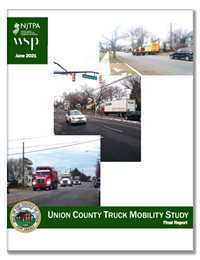 Union County is a center for freight activity in New Jersey, home to part of the East Coast’s largest port and one of the busiest cargo airports in the country.
Union County is a center for freight activity in New Jersey, home to part of the East Coast’s largest port and one of the busiest cargo airports in the country.
The volume of freight activity generates substantial truck traffic on Union County roads. The County launched the year-long Truck Mobility Study, in partnership with the NJTPA, to better understand how and where trucks are travelling; identify barriers to efficient and safe regional freight movement; and to recommend potential strategies to address those barriers.
The study aims to support and improve truck circulation, which is a critical part of residents’ lives. Trucks carry goods to businesses, deliver items purchased online directly to residents, and keep grocery stores stocked.
The study analyzed 174 miles of County roads and developed concepts for improving 10 locations, which the County will consider for implementation. The analysis considered vehicle, pedestrian and bicycle crash locations; existing conditions; freight generators; land use; and traffic data, among other factors. An initial list of 33 sites was selected based on this analysis. The final 10 sites were selected with input from a Technical Advisory Committee comprised of key stakeholders, focus groups, public outreach and county planning and engineering staff.
The concepts developed for each site are intended to serve as model that could be applied to other locations. The sites are:
| Street |
Cross Street |
Municipality |
Crash Hotspot |
Truck Generators |
Connector Route |
High Volume |
Point of Interest |
| Summit Ave (CR 657) |
Broad St (CR 512) to Springfield Ave |
Summit |
Truck/
BikePed |
Y |
NJ 24 |
N |
|
| Springfield Ave (CR 512) |
Passaic St (CR 647) to Academy St |
New Providence |
Truck |
Y |
NJ 24 |
N |
New Providence High School |
| New Providence Road |
Park ave (CR 655)/Bonnie Blum Rd (CR 641) |
Scotch Plains |
Truck |
Y |
I-78/US 22 |
N |
Weldon Concrete/
School |
| Vauxhaull road (CR 630) |
Liberty Ave |
Union Township |
Truck |
Y |
I-78/US 22 |
Y |
Jefferson Elementary School |
| Vauxhaull road (CR 630) |
Stuyvesant Ave (CR 619) |
Union Township |
Truck/
BikePed |
Y |
I-78/US 22/NJ 82/NJ 28 |
N |
|
| South Ave (CR 610) |
Centennial Ave (CR 619) |
Cranford |
Truck |
N |
US 1&9/NJ 28 |
Y |
Lincoln School |
| 1st Ave (CR 610) |
Locust St (CR 619) |
Roselle |
Truck/
BikePed |
N |
US 22/NJ 28/NJ 27 |
Y |
|
| Elizabeth Ave (CR 510) |
Scott ave (CR 650) to N. Stiles St (CR 615) |
Linden |
Truck |
Y |
CR parallel to US 1&9/NJ 27 |
Y |
Former GM Plant |
| Elizabeth Ave (CR 510) |
Wood Ave (CR 617) |
Linden |
Truck/
BikePed |
Y |
US 1&9/NJ 27/NJ 28/US 22 |
Y |
Linden Train Station |
| Wood Ave (CR 617) |
Linden Ave |
Linden |
Truck/
BikePed |
Y |
US 1&9/NJ 27/NJ 28/US 22 |
Y |
Linden Train Station |
Potential improvements include increasing capacity, improving signage and wayfinding, signal upgrades, limiting trucks on specific routes or providing alternate routes, increasing bridge clearances, and pedestrian or bicycle safety improvements.
The County plans to prioritize the projects and work with municipalities and the New Jersey Department of Transportation to implement the study’s recommendations.
Recommendations for each road are available in the
Final Report.
This study was completed through the NJTPA’s Subregional Studies Program, which provides two-year grants on a competitive annual basis to the 13 counties and two cities — known as subregions — represented on the NJTPA Board.
The program aims to help subregions develop recommendations for transportation improvements consistent with the NJTPA’s Long Range Transportation Plan.
Posted: 9/23/2021 9:15:54 AM
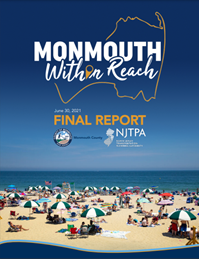 From beaches, to concert venues, parks, orchards, racetracks and more, Monmouth County has a variety of destinations and events that attract residents and tourists. But traffic congestion generated by trips to these locations can detract from the experience for everyone while also impacting the environment and the non-tourism sectors of local economies.
From beaches, to concert venues, parks, orchards, racetracks and more, Monmouth County has a variety of destinations and events that attract residents and tourists. But traffic congestion generated by trips to these locations can detract from the experience for everyone while also impacting the environment and the non-tourism sectors of local economies.
Monmouth County, in partnership with the NJTPA, conducted a year-long study, Monmouth Within Reach, to develop strategies to address congestion around key tourism locations. The study was just the first step in addressing congestion. The County will continue to work with municipalities and venues to implement the recommendations.
Five sites, representative of different location types, were selected for analysis. Strategies developed for each are intended to be applicable to similar sites throughout the county. The five locations/sectors are:
-
Asbury Park – This Jersey Shore community has a thriving downtown, beach, live concert destinations and hosts numerous events, including festivals, parades and fireworks.
-
Red Bank — The Borough’s downtown is one of the most popular in Monmouth County and features many different destinations, including theaters, nightlife, runs, festivals and fireworks.
-
Agritourism — This is one of the fastest growing tourism sectors in the county. Several major farms attract many visitors and more are expected to open in the future. Two popular tourist destinations, Holland Ridge Farms in Upper Freehold and Eastmont Orchards in Colts Neck, were selected for analysis.
-
Sandy Hook Gateway National Recreational Area/Sea Bright — Sandy Hook is one of the most visited national parks in the country. Nearby Sea Bright, which experiences congestion when Sandy Hook reaches capacity, features three miles of beachfront and has several restaurants that attract visitors.
-
The County Fair at East Freehold Showgrounds — The Monmouth County Fair, typically held in July, is the largest event and congestion-generator at the East Freehold Showgrounds.
The strategies suggested varied by site, but some examples include using variable message signs to provide coordinated visitor information, event information and advanced parking information; improving wayfinding; using apps to get information out to the public; encouraging carpooling, transit use, scooter or bike rentals; providing shuttle service; and using counter flow operations, which allow for the direction of some travel lanes to be changed to accommodate traffic increases in one direction.
Specific strategies for the selected locations are available in the final report.
This study was completed through the NJTPA’s Subregional Studies Program, which provides two-year grants on a competitive annual basis to the 13 counties and two cities — known as subregions — represented on the NJTPA Board.
The program aims to help subregions develop recommendations for transportation improvements consistent with the NJTPA’s Long Range Transportation Plan.
Posted: 9/17/2021 1:57:52 PM
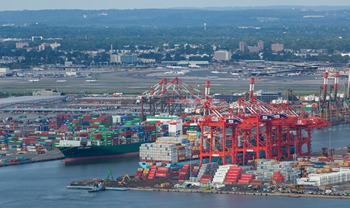 “COVID, perhaps more than any other event in recent memory, has highlighted just how important it is that we have resilient, diverse and secure supply chains,” Monica Gorman, Deputy Assistant Secretary Manufacturing Industry and Analysis at the International Trade Administration of the U.S. Department of Commerce, told the NJTPA Board at its September 13 meeting.
“COVID, perhaps more than any other event in recent memory, has highlighted just how important it is that we have resilient, diverse and secure supply chains,” Monica Gorman, Deputy Assistant Secretary Manufacturing Industry and Analysis at the International Trade Administration of the U.S. Department of Commerce, told the NJTPA Board at its September 13 meeting.
Gorman provided highlights from reports compiled in response to an executive order issued by President Biden in February. The order mandated analyses of critical aspects of the supply chain.
The reports call for investing in and strengthening the domestic manufacturing base; continuing and strengthening leadership in innovation and research and development; investing in the workforce; ensuring economic opportunity is available to all people across the country; and building a diverse ecosystem of suppliers, she said.
She said the Department of Commerce led the report on semiconductors, which play a critical role in transportation. For example, she said, a new car requires more than 100 semiconductors.
“Semiconductors enable telecommunications and grid infrastructure, they run our critical businesses, our transportation systems, our government systems, and they’re prevalent across a vast array of products from refrigerators to fighter jets,” she said.
Yet the United States’ share of global semiconductor production has fallen from 37 percent in 1990 to 12 percent this year, and she said that is expected to drop further without a comprehensive strategy for supporting the industry. The report calls for providing dedicated investment and funding for semiconductor manufacturing and research and development to support domestic production.
Acknowledging that not everything can be made domestically, she said the United States must also create geographic diversity among its supply chain.
Gorman also spoke about the need to support the Port of New York and New Jersey, which she called “a critical gateway for the supply chains that underpin American manufacturing.”
She said the Department of Commerce is aware of the many challenges the Port is facing including congestion, increased dwell times, equipment and storage shortages, and container shipping rates, while also experiencing near record cargo volumes. She noted the recent appointment of John Porcari as Port Envoy to the federal Supply Chain Disruption Task Force, where he will focus on addressing port congestion.
Gorman said she’s also hopeful the bipartisan federal infrastructure bill will help address issues at the ports and across the transportation sector. The U.S. Senate passed the bill in August, but it still must pass in the U.S. House of Representatives.
“It is truly a once in a generation opportunity to transform our infrastructure, including investing billions to improve our ports and waterways. The funding would help address congestion and supply chains over time by investing in the repair and maintenance needed to reduce congestion and emissions at the ports,” she said.
The bill also includes funding for New Jersey roads and bridges, NJ TRANSIT and for a new trans-Hudson rail tunnel, she added.
“The bipartisan infrastructure bill represents a historic investment in our country that will strengthen our economy to benefit our country and New Jerseyans for decades to come,” she said. Visit our YouTube channel to view the full presentation.
Posted: 9/16/2021 10:19:52 AM
Developers are scouring North Jersey and surrounding areas to find sites appropriate for building new warehouses to meet demand driven by burgeoning e-commerce, record growth of goods moving through the port, an economy rebounding from the pandemic and other factors. The expansion of warehousing and public sector efforts to address potential impacts on communities was the subject of a meeting of the Metropolitan Area Planning (MAP) Forum's Multi-State Freight Working Group on September 14. Visit the working group's webpage to view a recording of the workshop.
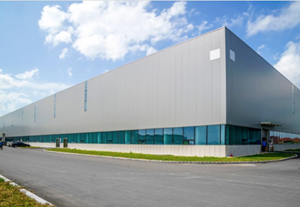 “The entire MAP Forum region has seen a profound growth in industrial development in recent years,” said Middlesex County Commissioner Charles Kenny, Chair of the NJTPA Freight Initiatives Committee, who welcomed participants. The MAP Forum is composed of representatives from 10 Metropolitan Planning Organizations in New York, New Jersey, Pennsylvania and Connecticut. Kenny noted that in North Jersey alone, 50 million square feet of industrial space has been added in the last four years, bringing the total to 862 million square feet.
“The entire MAP Forum region has seen a profound growth in industrial development in recent years,” said Middlesex County Commissioner Charles Kenny, Chair of the NJTPA Freight Initiatives Committee, who welcomed participants. The MAP Forum is composed of representatives from 10 Metropolitan Planning Organizations in New York, New Jersey, Pennsylvania and Connecticut. Kenny noted that in North Jersey alone, 50 million square feet of industrial space has been added in the last four years, bringing the total to 862 million square feet.
 “There is just a tremendous appetite for [warehouse] space that is hard to keep up with,” said Brian Banaszynski, who leads northeast industrial development at Transwestern Development Company. He said five years of expected growth in e-commerce was compressed into 18 months during the pandemic, greatly accelerating demand for warehouse space.
“There is just a tremendous appetite for [warehouse] space that is hard to keep up with,” said Brian Banaszynski, who leads northeast industrial development at Transwestern Development Company. He said five years of expected growth in e-commerce was compressed into 18 months during the pandemic, greatly accelerating demand for warehouse space.
The growth in demand has driven rents to record levels in North Jersey, topping $10 per square foot in many locations and as high as $20 per square foot in a prime location with access to the Lincoln Tunnel. Yet the rising rents, he said, “haven’t put a dent in vacancy rates,” which remain very low at 3 percent, compared to 9 percent in 2012.
He said the need for space, along with the greater regulatory hurdles to development in New Jersey, are pushing developers to pursue sites in surrounding areas, including Pennsylvania’s Lehigh Valley, South Jersey, Staten Island and Delaware. A constraint on this shift in development is that companies choose locations with ready access to a pool of labor, which is increasingly scarce.
Dan Disario of Langan Engineering and Environmental Services said most of the facilities being built are “modern high cube” warehouses, with high ceilings that can accommodate tall racking systems for storing goods.
However, traffic to and from the facilities varies according to their function. He gave the example of two adjacent facilities in Middlesex County: a 928,000-square-foot facility serving Volkswagen-Audi was the destination for 250 cars and 90 trucks over a 24-hour period; next door, a 774,000-square-foot facility serving Home Depot saw 200 cars and 185 trucks over the same period.
Amazon, which accounts for most new facilities in the region, seeks to control all aspects of the supply chain, from purchase to delivery, Disario said. This means the company leases and manages separate facilities for receiving goods, fulfillment (both for small sortable goods and larger non-sortable goods) and delivery stations for dispatching delivery vans. Many companies, he said, will be seeking to replicate Amazon’s comprehensive model, which will “generate sustained growth in warehousing” in coming years.
Echoing other speakers, Becky Bradley, Executive Director of the Lehigh Valley Planning Commission (LVPC), said her region is experiencing extraordinary demand for warehouse development, with proposals for 1 million square feet or more per month. She said this partly reflects the less stringent development requirements in Pennsylvania compared to New Jersey and other states.
Overall, she said the region was “going through the Wild West of industrial growth.” This has prompted LVPC to prepare a Community Guide on High Cube and Automated Warehouses. It includes a model ordinance for local government and other guidance. She noted that automation in the newest warehouses allows greater height and reduces the building footprint, which can help limit land use impacts.
Other freight planning tools were highlighted at the meeting. Mike Ruane, Manager of Freight and Aviation Planning at the Delaware Valley Regional Planning Commission, presented on the Philly Freight Finder; Gabrielle Fausel, a Principal Planner at the NJTPA, presented on an update to the NJTPA’s Freight Activity Locator; and Anne Strauss-Wieder, director of Freight Planning at the NJTPA, presented on the Goods Movement Strategies for Communities webtool.
Posted: 9/13/2021 3:15:27 PM
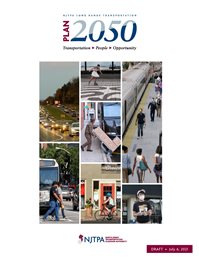 The NJTPA Board of Trustees today approved three key documents that will guide the agency’s work over the next several years — the Long Range Transportation Plan (LRTP), Fiscal Year 2022-2025 Transportation Improvement Program (TIP) and the Air Quality Conformity Determination.
The NJTPA Board of Trustees today approved three key documents that will guide the agency’s work over the next several years — the Long Range Transportation Plan (LRTP), Fiscal Year 2022-2025 Transportation Improvement Program (TIP) and the Air Quality Conformity Determination.
The long-range plan, Plan 2050: Transportation, People, Opportunity, presents a vision for the future of transportation in the region over the next 30 years.
“It prioritizes creating accessible and equitable transportation that addresses the needs of the people we serve, particularly low-income and minority communities,” said Morris County Commissioner Kathy DeFillippo, Chair of the NJTPA Board. “And of course, reducing crashes and ensuring the safety of all travelers remains a primary focus across all of our policies, programs, and investments.”
She noted that Plan 2050 was developed with extensive public engagement, which is reflected in the document. Commissioner DeFillippo highlighted several aspects of the plan in her remarks to the Board, including the focus on improving resiliency to storms, rising sea levels and other climate impacts; continuing a “fix it first” approach to repairing and maintaining the transportation system; improving transit; supporting active transportation, like bicycle and pedestrian improvements; and addressing freight infrastructure needs.
“I’m confident that Plan 2050 sets our region on the right course for the future,” she said.
The FY 2022-2025 TIP is the short-term implementation of Plan 2050. It is a fiscally constrained list of projects and programs undergoing various stages of work, including preliminary engineering, final design, right-of-way acquisition, and construction.
The Board approved the TIP. Warren County Commissioner Jason Sarnoski abstained from the vote noting the county’s ongoing discussions with the New Jersey Department of Transportation about concerns over a rockfall mitigation project on Interstate 80, which is included in the TIP.
Finally, the Board also approved the Air Quality Conformity Determination for both Plan 2050 and the TIP. This analysis confirmed that the projects and programs in the Plan and TIP meet federal air quality standards and do not worsen air quality in the region.
All of the documents, as well as a summary of public comments, are available at njtpa.org/Plan2050.
Posted: 9/10/2021 10:25:47 AM
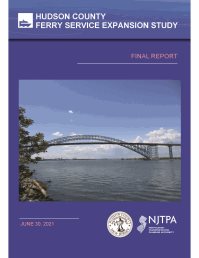 Hudson County recently completed a study to evaluate the feasibility and market demand for expanding ferry service.
Hudson County recently completed a study to evaluate the feasibility and market demand for expanding ferry service.
The study identified six potential locations for ferry landings, based on bridge heights, water depths and existing transportation service, among other factors. This included Bayonne’s Newark Bay waterfront, the Bayfront Redevelopment Area in Jersey City, south Harrison, Hoboken, South Kearny, and West New York.
These initial locations were narrowed down to four sites for further analysis. Some locations were removed from consideration due to existing ferry operations or constraints, like shallow shorelines. In addition, travel through the Kill Van Kull would create logistical issues with barge traffic, and ferry travel from western Hudson County to existing landings in the Hudson River would not provide a time savings to passengers, so those locations were also eliminated.
The four sites selected for detailed modeling were Bayfront, west Bayonne, south Harrison, and South Kearny, with proposed routes developed to connect the sites and nearby destinations. Focusing on the west side of Hudson County, the study was also able to concentrate efforts on the potential to provide transportation options for Hudson County’s environmental justice populations, including low-income and minority residents, as well as intra-New Jersey ferry service, which had not been analyzed before.
Although the study found that there was public and stakeholder interest in expanding ferry service, it determined there was not sufficient ridership demand at this time to make any of the routes feasible financially. However, proposed land developments around the areas studied could increase the number of potential riders in the future. The study recommends monitoring ridership demands and costs associated with expanding ferry service, and revisit implementing new service in the future.
This study was completed through the NJTPA’s Subregional Studies Program, which provides two-year grants on a competitive annual basis to the 13 counties and two cities — known as subregions — represented on the NJTPA Board.
The program aims to help subregions develop recommendations for transportation improvements consistent with the NJTPA’s Long Range Transportation Plan.
Click here to view the final report.